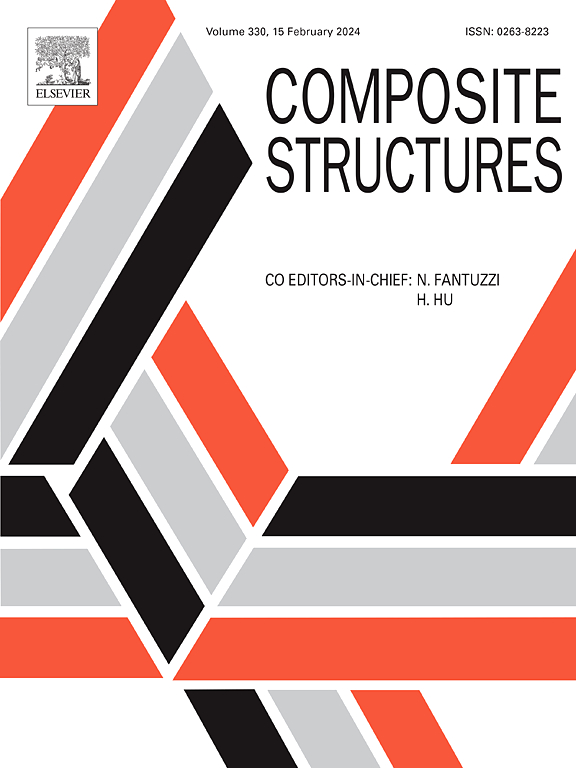An impact localization method for composite structures based on time series features and machine learning
IF 6.3
2区 材料科学
Q1 MATERIALS SCIENCE, COMPOSITES
引用次数: 0
Abstract
Aircraft composite structures are susceptible to visually undetectable internal damage from low-velocity impacts. However, their anisotropy and complex geometry lead to intricate impact signals, making localization highly challenging. In this paper, a two-step impact localization method based on time series features (TSF) and machine learning is proposed. The first stage of this methodology transforms impact response sequences from different zones into a spectrum of TSF sets, including recursive quantized features (RQF), recursive plot features (RPF) and gridded representation features (GPF). This is achieved using a time series image-based representation approach. Subsequently, three distinct convolutional neural networks (CNNs) are constructed, namely RQF-1DCNN, RPF-2DCNN and GPF-2DCNN. These networks are employed to mine and learn deep-level features of time-series data, thereby transforming the impact localization task into a time-series feature classification task, specifically impact zone identification. The second step aims to precisely identify the impact location within the zone by utilizing impact response data and geometric center-of-mass algorithms at known locations within the identified impact zone. The proposed method is validated through low-velocity impact tests on composite honeycomb panels and aircraft wing structures. Additionally, differences in impact localization accuracy among various network models are analyzed. This method offers a cost-effective solution, achieving high accuracy with fewer sensors and less training data. Test results demonstrate that the RPF-2DCNN and GPF-2DCNN models, which are based on image features, outperform the RQF-1DCNN for impact monitoring in composite structures, achieving reliable impact localization with data from a single sensor. Moreover, compared to GPF, RPF, with its deeper time response sequence, is more appropriate for impact monitoring on wing structures with complex structural characteristics.
基于时间序列特征和机器学习的复合材料结构冲击定位方法
飞机复合材料结构容易受到低速撞击造成的肉眼无法察觉的内部损伤。然而,它们的各向异性和复杂的几何形状导致了复杂的撞击信号,使得定位非常具有挑战性。提出了一种基于时间序列特征(TSF)和机器学习的两步冲击定位方法。该方法的第一阶段将来自不同区域的冲击响应序列转换为包含递归量化特征(RQF)、递归图特征(RPF)和网格表示特征(GPF)的TSF集合谱。这是使用基于时间序列图像的表示方法实现的。随后,构建了RQF-1DCNN、RPF-2DCNN和GPF-2DCNN三个不同的卷积神经网络(cnn)。利用这些网络挖掘和学习时间序列数据的深层次特征,从而将撞击定位任务转化为时间序列特征分类任务,即撞击区识别。第二步是利用已知位置的冲击响应数据和几何质心算法,精确识别区域内的冲击位置。通过复合材料蜂窝板和飞机机翼结构的低速冲击试验验证了该方法的有效性。此外,还分析了不同网络模型在冲击定位精度上的差异。该方法提供了一种经济有效的解决方案,可以用更少的传感器和更少的训练数据实现高精度。实验结果表明,基于图像特征的RPF-2DCNN和GPF-2DCNN模型在复合材料结构冲击监测方面优于RQF-1DCNN模型,可实现单传感器数据的可靠冲击定位。与GPF相比,RPF具有更深的时间响应序列,更适合于结构特性复杂的机翼结构的冲击监测。
本文章由计算机程序翻译,如有差异,请以英文原文为准。
求助全文
约1分钟内获得全文
求助全文
来源期刊

Composite Structures
工程技术-材料科学:复合
CiteScore
12.00
自引率
12.70%
发文量
1246
审稿时长
78 days
期刊介绍:
The past few decades have seen outstanding advances in the use of composite materials in structural applications. There can be little doubt that, within engineering circles, composites have revolutionised traditional design concepts and made possible an unparalleled range of new and exciting possibilities as viable materials for construction. Composite Structures, an International Journal, disseminates knowledge between users, manufacturers, designers and researchers involved in structures or structural components manufactured using composite materials.
The journal publishes papers which contribute to knowledge in the use of composite materials in engineering structures. Papers deal with design, research and development studies, experimental investigations, theoretical analysis and fabrication techniques relevant to the application of composites in load-bearing components for assemblies, ranging from individual components such as plates and shells to complete composite structures.
 求助内容:
求助内容: 应助结果提醒方式:
应助结果提醒方式:


